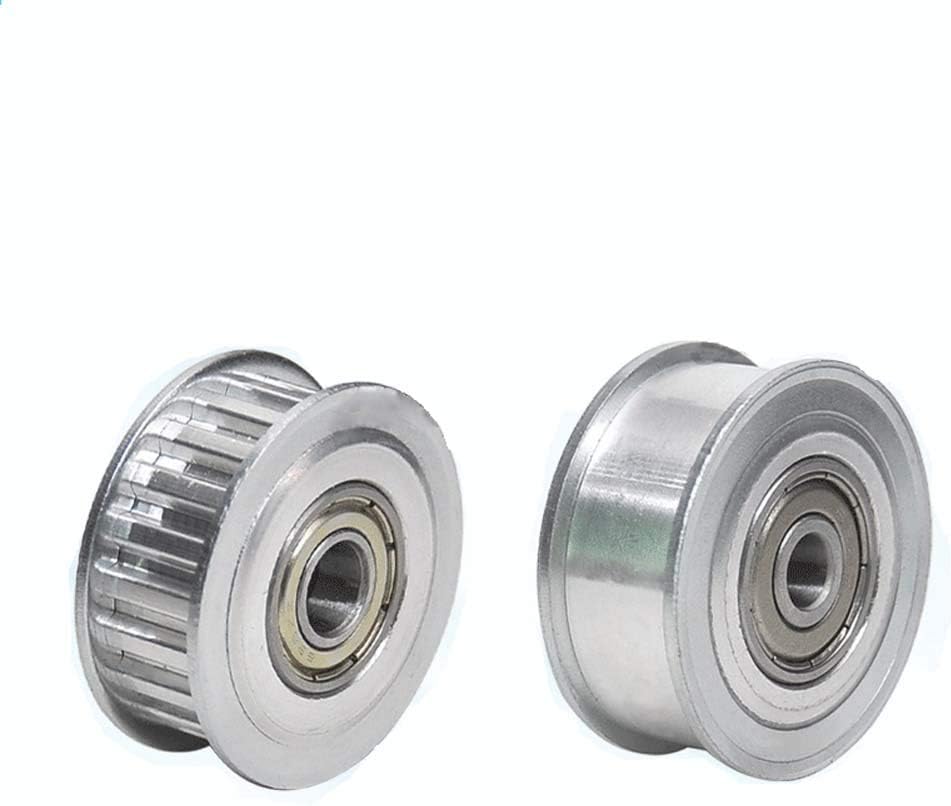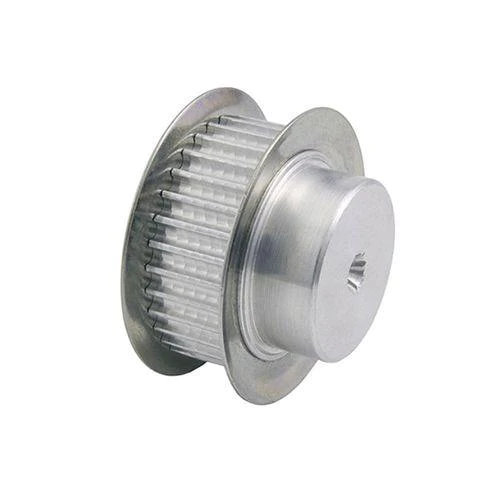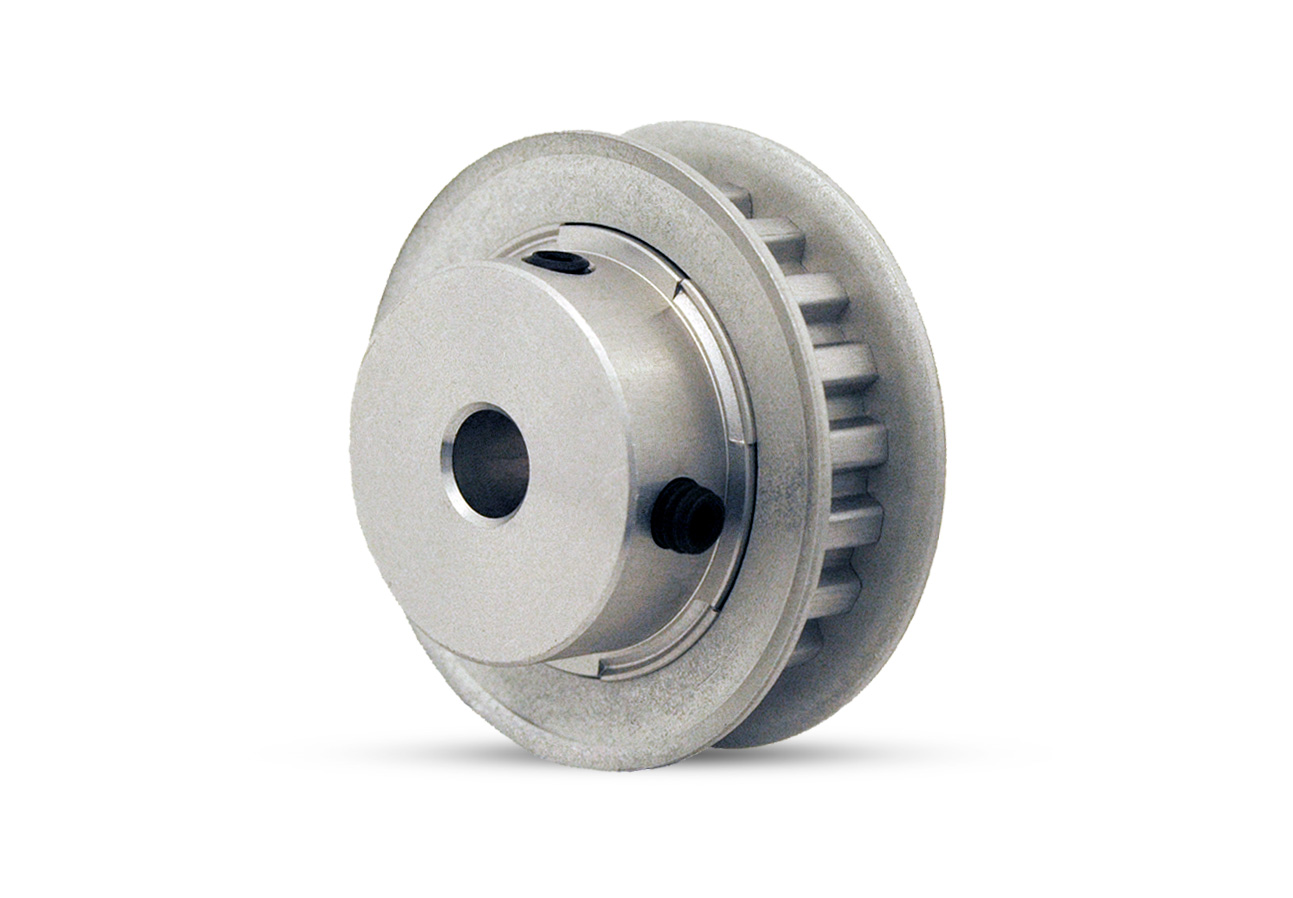Product Description
INDUSTRIAL TIMING PULLEY
. Feature
Our Timing Belt uses Japan-imported high quality synthetic neoprene, high quality glass fiber cord and tooth surface with nylon 66 high stretch do the protection. The timing belt adapts teeth or teeth mesh to transfer power. It needs no lubrication, no slip, no pollution, less noise. The transmission efficiency is over 98%, and the speed ratio can reach 1:10. Linear velocity can be up to 50m/s. Its dynamic bending wind gives a good fatigue performance, and good aging heat-resistance abrasion performance.
. Parameters
Figure 1. Physicomechanical Property
| Item | Trapezoid Teeth | Arc Teeth | ||||||||
| XL | L | H | XH | XXH | 3M | 5M | 8M | 14M | 20M | |
| Tensile Strength N/mm | 80 | 120 | 270 | 380 | 450 | 90 | 160 | 300 | 400 | 520 |
| Elongation Reference at Loading N | 60 | 90 | 220 | 300 | 360 | 70 | 130 | 240 | 320 | 410 |
| Adhesion strength of cloth N/mm | 5 | 6.5 | 8 | 10 | 12 | – | 6 | 10 | 12 | 15 |
| Adhesion strength of core N/mm | 200 | 300 | 600 | 800 | 1500 | – | 400 | 700 | 1200 | 1600 |
| Gear shearing intensity N/mm | 50 | 60 | 70 | 75 | 90 | – | 50 | 60 | 80 | 100 |
| Elongation ≤ % | 4% | |||||||||
| Hardness Shore A | 75 ± 5 | |||||||||
Figure 2: Belt Teeth Size
| Type | Pitch (pb) mm | Tooth height (ht) mm | Belt thick (hs) mm | Angle |
| MXL | 2.032 | 0.51 | 1.14 | 40º |
| XXL | 3.175 | 0.76 | 1.52 | 40º |
| XL | 5.080 | 1.27 | 2.3 | 40º |
| L | 9.525 | 1.91 | 3.6 | 40º |
| H | 12.7 | 2.29 | 4.3 | 40º |
| XH | 22.225 | 6.35 | 11.2 | 40º |
| XXH | 31.7 | 9.53 | 15.7 | 40º |
| T2.5 | 2.5 | 0.7 | 1.3 | 40º |
| T5 | 5.0 | 1.2 | 2.2 | 40º |
| T10 | 10 | 2.5 | 4.5 | 40º |
| T20 | 20 | 5.0 | 8.0 | 40º |
| AT5 | 5.0 | 1.2 | 2.7 | 40º |
| AT10 | 10 | 2.5 | 5.0 | 40º |
| AT20 | 20 | 5.0 | 8.0 | 40º |
. Production Equipment
01, pulley CNC processing zone 02, synchronous belt making machine 03, synchronous round roll teeth processing zone
04, synchornous belt curing processing zone 05, 3 roll calender 06, direct drive belt forming machine
07, pulley workshop timing mould
. Quality Testing
FAQ
Q1. Can I have a sample order?
Yes, any sample order is welcome to know the quality of our products.
Q2. What about the lead time of the sample or the final order?
2-5 days for normal sample.
20-30 days for a formal order.
Q3. How much is the minimum quantity for each item in 1 order?
One mould quantity is ok. Usually around 100pcs for small item, several dozens for big item.
Q4. Is it possible to print our logo or brand on the belt?
Yes, we can print your logo or design on the belt after receipt of your formal authorization letter of the logo or your brand.
Q5. Do you offer the guarantee for your product?
Yes, usually we offer 1 year warranty for all of our products.
| Standard or Nonstandard: | Standard |
|---|---|
| Application: | Electric Cars, Motorcycle, Car |
| Feature: | Wear-Resistant, High Temperature-Resistance |
| Tensile Strength: | Strong |
| Material: | Rubber |
| Type: | Toothed Belt |
| Samples: |
US$ 0.1/Piece
1 Piece(Min.Order) | |
|---|
| Customization: |
Available
| Customized Request |
|---|

Can XL pulleys be integrated into existing mechanical systems for upgrades?
Yes, XL pulleys can be integrated into existing mechanical systems for upgrades. Here is a detailed explanation of the integration process and the benefits of upgrading with XL pulleys:
1. Compatibility:
XL pulleys are designed to be compatible with standard timing belts, making them suitable for integration into existing systems that utilize timing belt drives. The pulleys are available in various sizes and tooth profiles, allowing for easy replacement and compatibility with different belt lengths and widths.
2. Improved Performance:
Integrating XL pulleys into an existing mechanical system can lead to improved performance. XL pulleys offer advantages such as higher torque capacity, increased speed capabilities, and better power transmission efficiency compared to smaller pulley sizes. Upgrading to XL pulleys can enhance the system’s overall performance, allowing for higher loads, faster speeds, and improved efficiency.
3. Enhanced System Precision:
XL pulleys are known for their precise tooth profiles and accurate dimensional control. By integrating XL pulleys, the system can benefit from improved positional accuracy and reduced backlash. This is particularly important in applications where precise positioning or synchronization is crucial, such as CNC machines, robotics, or high-precision conveyors.
4. Customization Options:
XL pulleys offer customization options, allowing them to be tailored to specific system requirements. Manufacturers can modify pulley dimensions, bore sizes, keyway configurations, or tooth profiles to match the existing system’s needs. This customization capability ensures a seamless integration into the system without the need for significant modifications or adaptations.
5. Cost-Effective Upgrade:
Integrating XL pulleys into an existing mechanical system can be a cost-effective upgrade option. Since the system’s core components, such as the shafts and bearings, remain unchanged, the upgrade primarily involves replacing the existing pulleys with XL pulleys. This reduces the cost and complexity associated with a complete system overhaul while still providing significant performance improvements.
6. Ease of Installation:
The integration of XL pulleys into existing systems is relatively straightforward. The process typically involves removing the old pulleys and replacing them with the new XL pulleys. As long as the pulley dimensions and tooth profiles are compatible, installation can be completed with basic tools and minimal downtime.
7. System Scalability:
XL pulleys offer scalability options, allowing for future system expansions or modifications. If the mechanical system requires capacity upgrades or changes in operating conditions, integrating XL pulleys provides flexibility for system scalability. Additional pulleys can be easily added or replaced to accommodate the evolving needs of the system.
In summary, XL pulleys can be successfully integrated into existing mechanical systems for upgrades. The compatibility, improved performance, enhanced precision, customization options, cost-effectiveness, ease of installation, and system scalability make XL pulleys a viable choice for upgrading mechanical systems to achieve better performance, efficiency, and adaptability.

How does the size of an XL pulley impact its load-bearing capacity?
The size of an XL pulley plays a significant role in determining its load-bearing capacity. Here’s how the size of an XL pulley impacts its load-bearing capacity:
1. Surface Area:
The size of the pulley affects the surface area over which the force is distributed. Larger pulleys generally have a larger surface area, allowing for better force distribution and reducing the stress concentration on the pulley. This increased surface area helps in handling higher loads and reduces the risk of pulley failure.
2. Moment Arm:
The size of the pulley also affects the moment arm, which is the perpendicular distance from the center of the pulley to the line of action of the force. A larger pulley typically has a longer moment arm, resulting in a larger torque or moment applied to the pulley. This increased torque capacity allows the pulley to handle higher loads without experiencing excessive deflection or failure.
3. Tooth Engagement:
XL pulleys transmit power through the engagement of their teeth with the corresponding teeth on the timing belt. The size of the pulley determines the number of teeth and the contact area between the pulley and the belt. A larger pulley with more teeth provides increased contact area and better tooth engagement, resulting in improved load-bearing capacity and power transmission efficiency.
4. Material Strength:
The size of the pulley can also impact the selection of materials with appropriate strength properties. Larger pulleys may require materials with higher strength to withstand the increased loads. The choice of materials with adequate tensile strength, fatigue resistance, and durability becomes crucial in ensuring the load-bearing capacity of the pulley.
5. Speed and Torque:
The size of the pulley influences the speed and torque characteristics of the system. Larger pulleys can accommodate larger belts, resulting in increased belt contact surface and improved power transmission. This allows for higher torque transfer capabilities, enabling the pulley to handle heavier loads.
It’s important to note that while larger pulleys generally have higher load-bearing capacities, other factors such as material properties, design considerations, and proper installation also influence the overall load capacity of the pulley system. Therefore, it is essential to consult the manufacturer’s guidelines and engineering calculations to determine the appropriate pulley size and ensure safe operation under the desired load conditions.

What is an XL pulley, and how does it differ from other pulley types?
An XL pulley is a specific type of pulley commonly used in power transmission systems. It belongs to the family of timing belt pulleys, which are designed to work in conjunction with timing belts for precise motion control. Here are the key characteristics and differences of XL pulleys compared to other pulley types:
1. Tooth Profile:
XL pulleys have a tooth profile that is compatible with XL timing belts. The tooth profile is designed to accurately engage with the corresponding teeth on the timing belt, ensuring precise and synchronous motion transfer. The tooth profile of an XL pulley typically has a trapezoidal shape with a specific pitch and tooth height, which differs from other pulley types.
2. Pitch Size:
The pitch size of an XL pulley refers to the distance between adjacent tooth centers. XL pulleys have a pitch size of 0.200 inches (5.08 mm). This pitch size is standardized and ensures compatibility with XL timing belts of the same pitch, allowing for easy interchangeability and system design flexibility.
3. Belt Width Compatibility:
XL pulleys are designed to accommodate XL timing belts of specific widths. The belt width is determined by the application requirements and load considerations. XL pulleys are available in various groove widths to match the corresponding XL timing belt width, ensuring proper belt engagement and power transmission.
4. Material and Construction:
XL pulleys are commonly made from materials such as aluminum, steel, or plastic, depending on the application requirements. The choice of material affects the pulley’s durability, weight, and resistance to wear. The pulleys are typically precision-machined to ensure accurate tooth profiles, smooth operation, and reliable performance.
5. Application Range:
XL pulleys are widely used in applications that require precise motion control, such as robotics, CNC machines, 3D printers, and other automated systems. They are suitable for moderate to high torque requirements and can handle a range of speeds and loads, depending on the specific pulley size, material, and construction.
6. Interchangeability:
One of the advantages of XL pulleys is their interchangeability. Since they adhere to standardized pitch sizes and tooth profiles, XL pulleys from different manufacturers can be used interchangeably with XL timing belts of the same specifications. This interchangeability simplifies replacement, maintenance, and system upgrades.
In summary, an XL pulley is a type of timing belt pulley designed for precise motion control. It differs from other pulley types in terms of its tooth profile, pitch size, belt width compatibility, material and construction, application range, and interchangeability. Understanding these differences is crucial for selecting the appropriate pulley type for specific power transmission requirements.


editor by CX
2023-11-27